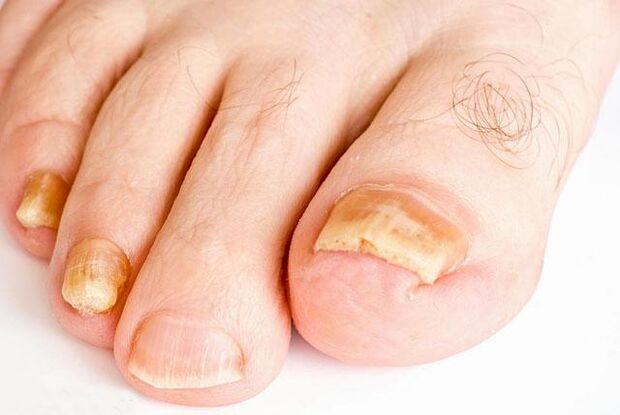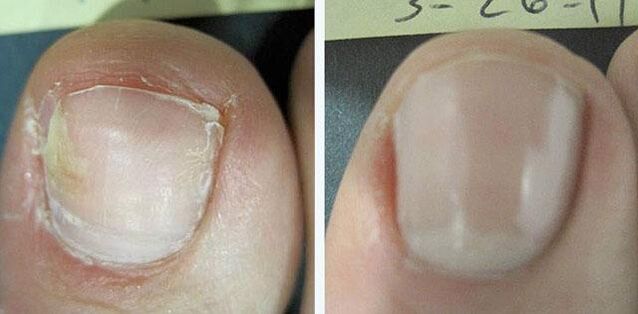
Onychomycosis is a widespread onychomycosis (up to 18% of the population). It affects people of all ages, and an increase in the number of people affected over the past decade has also been recorded in teenagers and children. Due to frequent and repeated exposure, the treatment of nail fungus, foot fungus is a complex and lengthy process.
When did the infection happen?
- In households sharing footwear, household appliances (bathroom rugs) and body care products (washcloths, manicures sets);
- Upon access to swimming pools, showers at the gyms and at the factories, saunas and baths.
Pathogens of the disease
Effective treatment of nail fungus is only possible with the correct diagnosis of the pathogen in the laboratory. In nearly 90% of cases, onychomycosis is caused by different types of skin fungus. A particular species affects the respective parts of the body with its characteristics:
- the toenails and hands, as well as any part of the skin;
- nail plates on the feet and skin of the III-IV inter-vertebrae, arch of the foot, upper third of the soles of the feet, lateral surfaces of the toes.
In more rare cases, the disease is caused by other fungi - trichophytos, the epidermis, less often - like yeast. Very rarely, onychomycosis can be caused by a mold affecting the nails in the first toe area, mainly in people over 50 years old.
Contributing factors
Favorable conditions for the penetration and development of the infection:
- Damage to the nail and surrounding skin. This usually happens due to tight shoes, cosmetic procedures.
- Broken fingers and feet or hand bones.
- Swollen legs in heart disease, atherosclerosis of the lower extremities, varicose veins, Raynaud's disease (spasm of the upper limb artery).
- Endocrine diseases (especially diabetes mellitus).
- Pregnancy (due to hormonal changes and decreased immunity).
- Decreased general immunity.
- Birth defects in the formation of the horny layer of the skin.
- Severe and long-term chronic illnesses impair the body's ability to defend itself.
- Long-term treatment with corticosteroids and antibiotics, other systemic and immune diseases.
Proven ability to transmit infection in the body with blood and lymph.
Diagnosis of onychomycosis
Diagnosis of fungal infection is based on local and general clinical findings and laboratory studies.

Clinical manifestations
Symptoms vary widely and depend on the type and type of pathogen. Particularly the toenails (80%) and hands may be affected; Less common is that the fingernails of the lower and upper extremities are lost simultaneously.
Depending on the nature of the change in the foundation plate, 4 types of damage are distinguished:
- Normotrophic- Characterized by a yellowish color on the end edge of the nail plate. The skin becomes dull and thickened due to the horny layer of the epidermis (subcutaneous hyperkeratosis). The shape of the affected nail does not change over a long period of time.
- Big boomIn which nails become yellow and thicken, edges become loose. Gradually horizontal lines appear. Nails become gray and dull. In some cases, it (usually on the first toes) thickens, becomes long and curved like a hooves or rostrum (onychomycosis).
- Atrophic- the nails are dull, grayish or yellowish. They change shape, collapse on the bottom edge, exposing part of the bed. It is then covered with loose layers of the horny layer.
- Anesthetic- Separate the nail plate from the bed. With this form of fungal infection, the normal color remains only in the root zone. The remainder of the nail becomes thinner, separates from the nail layer, loses shine, and becomes a yellowish or dirty gray.
Combination patterns are often observed. The listed clinical manifestations are nonspecific for specific types of fungal lesions. They can also develop non-fungal diseases.
Some common manifestations can also occur: allergic rash on the body, increased fatigue, loss of appetite. They are explained by the ability of certain types of allergic skin fungi to restructure the body, and molds - release toxins, leading to chronic intoxication of the whole body.
Diagnosis in the laboratory
It is included in the material collection (particles of the epidermis, nail fragments). The material is poured with caustic alkaline solution, left for 24 hours at a temperature of about 20 degrees, after which it is examined under a microscope. This technique allows for a differential diagnosis between fungal and non-fungal lesions. In the presence of fungi, fibers of varying thickness and shape, groups of spores are visible under a microscope.
Then, the material is sown on a special nutrient medium for the growth of the pathogen, followed by identification of its type and sensitivity to the antifungal agent.
Treatment features
When choosing the method of treatment, it is necessary to take into account the form, type and extent of the injury, the rate of nail growth, the general condition of the body and the side effects of the drugs used, especially in the presence of diseases. at the same time. Based on these principles, the treatment of toenail fungus, as well as on the hand, involves local or complex effects.
Principle of local impact
Can happen if:
- The infection did not affect all of the nails;
- the defeat of each infected nail plate is less than half of its area;
- this process is located only at the end and on the sides of the plate, and not to the base;
- has contraindications to the use of drugs for the whole body.
Treatment with local drugs
This includes the use of nail emollients, lotions, or creams. They also include drugs to treat nail fungus (hands), stop the growth and development of infection:
You can pre-apply any preparation to soften the plaque and remove it layer by layer, as in the first case, then apply a broad spectrum antifungal 2 times a day in the form of a cream or solution. At the same time, it is necessary to rub them into the surrounding skin.

Pedicure medical hardware
Medical pedicure is used as an additional procedure (but not a treatment! ), Which shortens the time of treatment. Its essence is to use a router with an attachment in the form of a metal or diamond cutter. This device significantly facilitates the easy removal of previously softened nails from the bed. The use of the hardware method is recommended when more than 60% of the area of the nail is damaged, but does not replace drug treatment with antispasmodics.
Surgery
In the case of severe onychomycosis with severe deformation of the nail, it is sometimes surgically removed under general anesthesia or conduction anesthesia with the addition of an antifungal agent. The main disadvantage of this method is to damage the nail layer, so the newly grown nail plate will be left behind and have an irregular shape.
Get laser treatment
This method involves heating the nail with laser radiation in a short pulse range to a temperature of 45-47 degrees, at which dermatological bacteria die. This procedure is most effective at the early stages of a damaged nail without deformation. Depending on the degree that it is necessary to perform from 1 to 8 sessions with time intervals from 7 to 60 days. In severe injuries, it is recommended to treat topically and throughout the body.

Systemic drug treatment
It is indicated for multiple lesions of the nail, involvement of the roots in the process and without the effect of local contact.
The most effective treatment for nail fungus is pills. Contains substances such as terbinafine, fluconazole, and others. They are prescribed in courses for 3-4 months, and remain in the body after the end of treatment for up to 9 months. The last two drugs, due to their toxic effects on the liver, are used much less frequently.
Systemic treatment is contraindicated in kidney and liver diseases. During pregnancy and lactation, only one to two nails should be treated locally, but it is better to limit it.


























